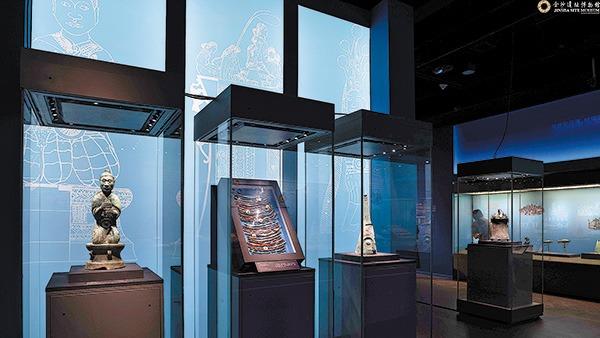 A large bronzeware exhibition is being held at Jinsha Site Museum in Chengdu, Sichuan province. (PHOTO PROVIDED TO CHINA DAILY)
A large bronzeware exhibition is being held at Jinsha Site Museum in Chengdu, Sichuan province. (PHOTO PROVIDED TO CHINA DAILY)
The Jinsha Site Museum in Chengdu, Sichuan province, has been holding Southwest China's largest bronzeware exhibition ahead of the start of the FISU World University Games on Friday.
The exhibition, which began on May 27 and will run through to Aug 27, has brought together 294 cultural relics from the Neolithic Age to the Han Dynasty (206 BC-AD 220). They are from 32 cultural institutions in Yunnan, Guizhou and Sichuan provinces, the Guangxi Zhuang autonomous region and Chongqing municipality.
Archaeologists hail the Jinsha Ruins as one of Sichuan's most important archaeological findings since the discovery of the Sanxingdui Ruins
Southwest China, which has been inhabited by many ethnic groups since ancient times, has rich nonferrous metal resources, and saw the emergence of a splendid bronze culture, says Zhu Zhangyi, curator of the Jinsha Site Museum.
READ MORE: Sichuan reveals its treasures
The bronze exhibits are drawn from cultural institutions and the latest archaeological discoveries, including a bronze kneeling figure with a twisted head and a distinctive bronze statue unearthed from the Sanxingdui Ruins in Guanghan, Sichuan province, in recent years.
The relics show the social outlook, religious beliefs and artistic aesthetics of the era in Southwest China and reveal the development pattern of the diversity and integration of Chinese civilization, Zhu says.
The Sanxingdui Ruins were discovered in 1929 by a farmer digging a ditch in his fields.
Findings confirmed the ruins, established between 2,800 and 4,800 years ago, housed the remains of a city that was the political, economic and cultural center of the ancient Shu (ancient name for Sichuan) state.
 A visitor looks at a bronze artifact, excavated from the Sanxingdui Ruins, that is on display in the Jinsha Site Museum. (PHOTO PROVIDED TO CHINA DAILY)
A visitor looks at a bronze artifact, excavated from the Sanxingdui Ruins, that is on display in the Jinsha Site Museum. (PHOTO PROVIDED TO CHINA DAILY)
One of China's most important archaeological discoveries of the 20th century, the ruins located on the upper reaches of the Yangtze River serve as convincing proof that the origins of Chinese civilization are diverse, as it rejects theories that the Yellow River is the sole origin, according to Duan Yu, who is a historian with the Sichuan Academy of Social Sciences.
Archaeologists hail the Jinsha Ruins as one of Sichuan's most important archaeological findings since the discovery of the Sanxingdui Ruins.
On Feb 8, 2001, builders working on an apartment construction site in Jinsha village in Chengdu found ivory and jade pieces among piles of earth.
Since then, archaeologists have excavated more than 10,000 relics including gold, jade, bronze and stone wares, as well as one metric ton of whole elephant tusks and tens of thousands of pottery and ceramic shards.
READ MORE: Shedding light on ancient culture
Jinsha is known as one of the country's most prolific excavations in terms of gold and the number of artifacts unearthed. It is also one of the world's largest excavations of ancient elephant tusks, Zhu says.
The Jinsha Ruins are most likely to be the political and cultural center to which the ancient Shu state moved from Sanxingdui about 3,000 years ago, says Zhu, who has been an archaeologist since his participation in the excavation of the No 1 and No 2 pits of the Sanxingdui Ruins in 1986.
As a matter of fact, both the Sanxingdui and Jinsha ruins are closely related. The National Cultural Heritage Administration is promoting their joint application for inclusion on the UNESCO World Heritage List, Zhu says.


